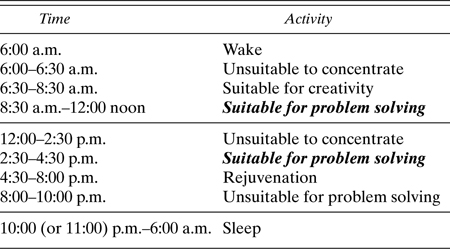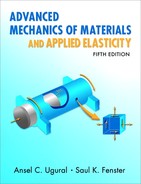Appendix A. Problem Formulation and Solution
A consistent, systematic procedure is required for solving problems in the mechanics of solids. A basic method of attack for any analysis problems is to define (or understand) the problem. Formulation of the problem requires consideration of the physical situations and an idealized description by the pertinent diagrams that approximate the actual component under consideration. The following five steps may be helpful in formulation and solution of a problem:
1. Define the problem and state briefly what is given.
2. State consistently what is to be determined.
3. List simplifying assumptions to be made.
4. Apply the appropriate equations to find the unknowns.
5. Comment on the results briefly.
Problem statement should indicate clearly what information is required. Free-body diagrams must be complete, showing all essential quantities involved. Assumptions or idealizations expand on the given information to further constrain the problem. For example, one might take the effects of friction to be disregarded or the weight of the member can be omitted in a particular situation. Solutions must be based on the principles of mechanics solids, formulas, tables, and diagrams. Comments present the key aspects of the solution.
Numerical Accuracy
In engineering problems of practical significance, the data are seldom known with an accuracy greater than 0.2%. Hence, the answers to such problems should not be written with an accuracy greater than 0.2%. Calculations are often performed by electronic calculators and computers, usually carrying eight or nine digits. So, the possibility exists that numerical result will be reported to an accuracy that has no physical meaning. Throughout this book, we usually follow a common engineering rule to report the final results of calculations:
• Numbers beginning with “1” are recorded to four significant digits.
• All other numbers (that begin with “2” through “9”) are recorded to three significant digits.
Consequently, a force of 18 N, for example, should read 18.00 N, and a force of 56 N should read 56.0 N. Intermediate results, if retained for further calculations, are recorded to many additional digits to maintain the numerical accuracy. The values of π and trigonometric functions are calculated to several significant digits (10 or more) within the calculator or computer. We note that, in some cases, such as when data is read from a graph, fewer significant digits may be recorded. In these situations, given data are assumed to be accurate to the number of significant digits indicated in the preceding. Various computational tools that may be used to perform analysis calculations are discussed in Section 7.16.
Daily Planning
Learning to pay attention to our own internal body clock, or brain cells controlling the timing of our behavior, and daily planning can help us make the best of our time. A tentative schedule for the “morning person” who prefers to wake up early and go to sleep early is given in Table A.1 (Ref. A.1). The “evening person” works late and wakes up late. Most individuals may shift times from one to another and others combine some characteristics of both.
Table A.1. The Best Time to Do Everything

We note that creativity serves well for open-ended thinking. Rejuvenation is renewing the mind with activities like reading, art work, and puzzle solving. It is unsuitable to concentrate when the body’s biological clock changes. During times suitable for problem solving, concentration is the highest for analysis.
Reference
A.1. UGURAL, A. C., Living Better: A Guide to Health, Happiness, and Managing Stress, Eloquent Books, New York, 2009, Sec. 20. (www.eloquentbooks.com or www.amazon.com)
